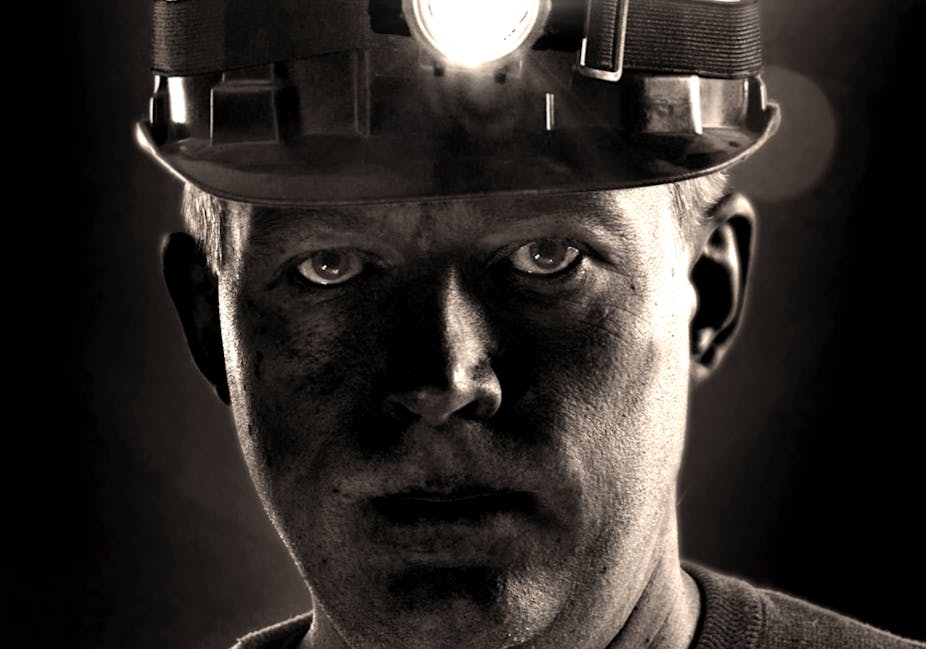All languages contain different accents and dialects and these aren’t just linked with geographical location. We have other speech registers and these can be linked to social class, ethnicity, sexuality, age or specific occupations.
While I was carrying out research on language variation in the East Midlands, some of the people I met suggested I speak with some local coal miners, “as they had a funny language all of their own”. And once I did, I discovered that many of the terms and words they used comprised a completely unique – and much overlooked – language variety, which I have since referred to as “pit talk”.
It quickly became clear that the East Midlands had not one, but several different variations of this pit talk. This is the language used by miners in their daily work and allows them to refer to their tools, job descriptions and other aspects of daily life. It is a language which is distinctive but is now at risk of being lost following the widespread colliery closures across the country. Examples include words such as “motties” or “tallies” (the identity discs worn by miners) and the “cage” (used to refer to the lift that led to the mines).
Funding from Nottingham Trent University and The British Academy, helped build on the research. The publicity around the project has also attracted the attention of people and local mining groups who wanted to participate.
Pitmatic
There had already been some work done on miners’ language in the the south Midlands and in the north-east of England, where it is referred to as “pitmatic”, but there had been no systematic research in the East Midlands. Research into mining heritage and culture frequently focuses on the tangible (the objects used by miners), but the intangible – the memories and the language used to describe them – is just as important.
The use of this language emphasised and strengthened the miners’ comradeship and “brotherhood” (which they themselves refer to) that was needed to work in such unpleasant and dangerous conditions. Following mine closures in Scotland and north-east England, many miners moved to the East Midlands and took their language with them to mix with the variety already present there. This allows us to see how incoming varieties affected the existing language, with terms such as “marra” (a north-east word for “mate”) now being used by some East Midlands miners.

Together we were able to create a preliminary list of pit talk words and expressions used by miners, published as Pit Talk of the East Midlands.
The book includes information from miners from different areas of the East Midlands. Some mining terms were used in some collieries, but not others, while others, such as “snap” (to refer to lunch or dinner time) were used by all miners in the region. In other parts of the country, meanwhile, “snap” is referred to as “bait” (in the north-east) or “piece” (Scotland). There are other terms which are used by some miners, but not others, such as “dudley”, which describes a water bottle used by miners.
Stinkdamp
There are particular differences between the language used by Leicestershire miners and that spoken by those from Nottinghamshire and Derbyshire. Leicestershire’s mines were geographically separate from the rest of the East Midlands coalfield and miners there reported using unique words such as “ringer” (a crowbar) and “stint” (used to describe a length of coal). Words to describe the dangerous working conditions, however, were used more generally. “Afterdamp”, “blackdamp”, “chokedamp”, “stinkdamp”, “firedamp”, “sweetdamp” and “whitedamp” were used widely, for example, to describe the various noxious gasses found in the mines, ranging from carbon monoxide to methane.

There were also many words to describe different tools and job descriptions, some of which can also tell us about the modernisation of collieries. The “hostlers”, men who worked the pit ponies, went redundant long before many of the mines closed. “Ganger” was also used as a name for those who mastered the ponies, and was later used to describe the men who moved coal and equipment along the underground roadways in “tubs” (coal containers) or “panzers” (electric conveyor belts) after the ponies were replaced.
Many job terms were descriptive: “Sinkers” were in charge of sinking new shafts, “sparkies” were electricians, “fitters” were mechanics, “powder monkeys” carried the explosives and assisted the “shot firers” who carried out the controlled explosions. “Borers” carried drills and drilled holes, “chockers” put up the roof supports as new tunnels were created, and “back rippers” removed these supports.
Floors in the mine could lift up unexpectedly due to geological faults and those who levelled them out again were called “dinters”. The man in charge of the conveyor belt was the “belt driver”, and the “onsetter” and “offsetter” were in charge of loading and unloading the lifts (which were also called “cages” or “chairs”). The men in charge of the lifts were called “banksmen” while the “bell man” would ring a bell to signal that it was safe to haul the coal or men up or down.
With the closure of the last coal mines and the ageing mining population, we must now collect such data with a greater sense of urgency as it will soon be lost to us forever. This language forms a large part of the identity and camaraderie of the miners and should be preserved for future generations to understand.

